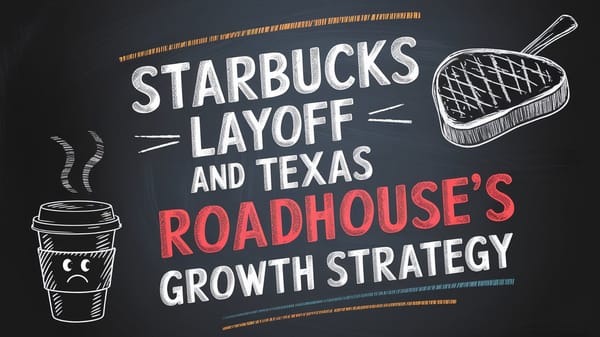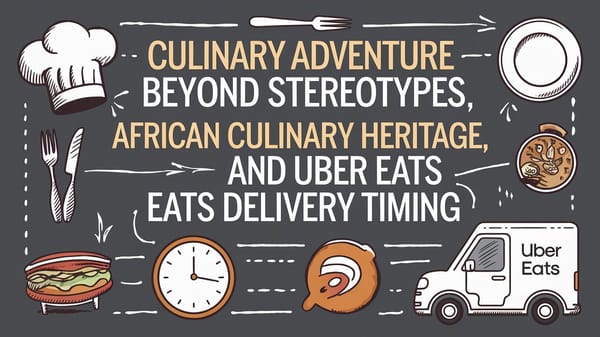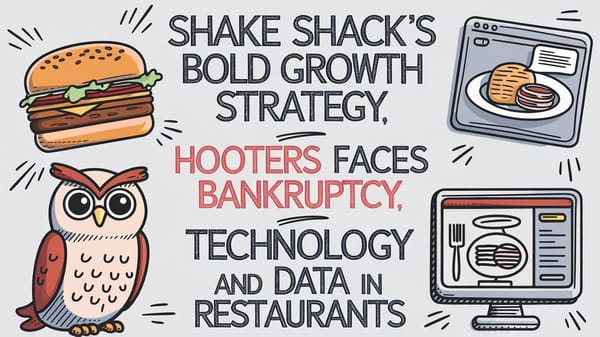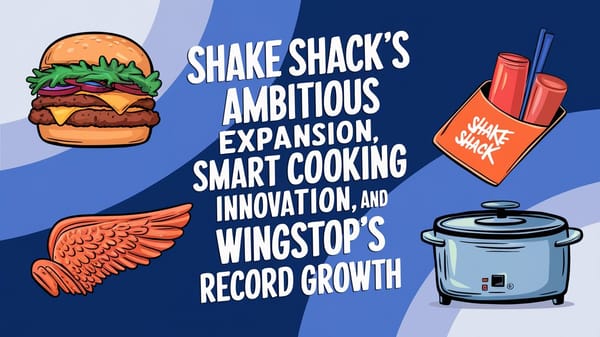September 29th QSR Roundup: Women's Leadership Gains, Restaurant Spending Trends, and AI in Dining

QSR news for Sep 29, 2024. We checked 18 QSR publications, 5 subreddits, and over 23 articles for you to bring the latest news. Estimated reading time saved (at 200wpm): 140 minutes. It will take you only 16 minutes to catch up.
Women in Corporate America: 10-Year Review
Source: QSR Magazine
- Representation Gains: Women's presence in corporate leadership has increased to 29% in C-suite roles, up from 17% in 2015.
- Broken Rung: Only 3% and 2% increases for women at entry and manager levels, highlighting ongoing challenges.
- Diversity Gaps: Women of color hold just 7% of C-suite positions, significantly lower than 22% held by white women.
- Cultural Stagnation: Despite some progress, companies are struggling to maintain commitment to diversity; 87% of companies prioritized gender diversity in 2019 compared to just 78% in 2024.
- Employee Experience: Nearly 61% of Black women believe race adversely affects their career prospects, emphasizing the need for better mentorship and support.
Future Outlook: At the current pace, achieving parity for all women is estimated to take 50 years; companies must address the broken rung and invest in developing women leaders.
Restaurant Spending Trends
Source: QSR Magazine
- Diners are adapting to inflation by spending $219 monthly on average at restaurants, with notable increases among those aged 45-60 (20%) and under 30 (low teens%).
- 36% of diners reported spending less, often due to inconvenience and costs.
- Starbucks and The Cheesecake Factory are viewed as too expensive, yet The Cheesecake Factory boasts a high value perception despite mixed traffic trends.
- Off-premises business (drive-thru, takeout, delivery) now represents 65% of restaurant interactions, highlighting a shift in consumer behavior.
- 60% of consumers are comfortable using QR codes for ordering, though a preference for physical menus persists.
55% of customers actively engage in loyalty programs, enhancing their restaurant choices, with younger demographics leading this trend.
AI Enhances Restaurant Experience
Source: QSR Magazine
AI shouldn't be seen as a one-size-fits-all solution; instead, it needs to address specific challenges in the restaurant industry.
- Personalized Ordering: Harnessing AI to analyze guest data allows restaurants to offer tailored menu recommendations, enhancing the digital experience and boosting sales.
- Kitchen Efficiency: Real-time data collection through AI optimizes kitchen operations, ensuring timely food preparation without compromising quality.
- Improved Delivery: AI transforms delivery from a weak point into a strength by optimizing routes and providing real-time updates, aiming for a premium at-home dining experience.
Unified Systems Essential: To maximize AI's effectiveness, comprehensive data across the restaurant's operations is crucial, connecting ordering, kitchen, and delivery processes for better insights.
Charleston’s Gulf-Inspired Gumbo
Source: Food & Wine
Discover the essence of Charleston through Mike Lata's oyster and okra gumbo, showcasing local ingredients and cultural nuances.
- Oysters: Lata hails mariculture as environmentally beneficial while highlighting its unique taste that captures the region's essence.
- Culinary Heritage: Each gumbo variation reflects local seasonality, with summertime bringing a wealth of flavors like okra and tomatoes.
- Rice Tradition: Contrary to common practices, Lata emphasizes gumbo is not merely a rice dish, presenting it separately to enhance flavor experience.
Local Palate: Lata promotes a collective identity among chefs using Lowcountry ingredients, urging visitors to grasp Charleston’s culinary uniqueness.
Wine Pairing Secrets
Source: Food & Wine
- Key Principle: Pair wines based on acidity; the wine should be as acidic or more acidic than the food.
- Example Pairing: Champagne (2.5 pH) complements fried chicken and other low-acid, fatty dishes.
- High-Acid Whites: Albariño, Riesling, Chablis, and Gewürztraminer shine with rich dishes.
- High-Acid Reds: Barbera, Chianti Classico, and Gamay work similarly well.
- Salivation Test: Gauge acidity by salivation; more saliva indicates higher acidity in wine.
- Flavor Combinations: Think of vinegar-based sauces with fried foods for balance – like pairing ketchup with fries.
Pork Pairing Wisdom: When in doubt with pork, always choose Pinot Noir!
From Pies to Bourbon
Source: Food & Wine
Scott Blackwell transitioned from baking pies to distilling bourbon, spending nine years reviving the nearly extinct Jimmy Red corn. His distillery, High Wire Distilling Co., utilizes this heirloom corn exclusively, crafting a bourbon known for its complex flavor profile—think graham, spice, and a dessert-like sweetness. The bourbon, aged for a minimum of two years, showcases the unique terroir of the region through tours and tastings in Charleston, South Carolina, inviting fans to experience the essence of their craft firsthand.
Transition to Online Invoicing
Source: /r/restaurantowners
The original post inquires about moving from paper invoices to an all-online system for accounts payable (AP), which sparks a discussion among restaurant owners about their experiences and challenges with digitizing invoicing. Many commenters express frustration with vendors who still rely on traditional methods, indicating a preference for digital solutions. One user shares their success using RASI to automate invoice collection via email, allowing them to streamline their accounts payable process and complete expense reports more efficiently. Another commenter mentions the use of an Epson scanner for invoices, but notes limitations with certain vendors who are still not offering digital options, especially in rural areas. Overall, there is a consensus that while transitioning to online invoicing can significantly improve efficiency, the reluctance of some vendors to adapt poses challenges.**
Late Night Diner Dilemma
Source: /r/restaurant
A Reddit post recounts a server's frustrating encounter with rude customers arriving shortly before closing time. The server explained the restaurant's policy of not taking orders close to closing time, yet the customers insisted on ordering complicated meals, leading to tensions. Many commenters supported the server, arguing that restaurants need clear policies about last seating or closing times. Some suggested managers should support their staff against disrespectful customers, while others emphasized that customer service should remain professional, even in difficult situations. Insights highlighted include the importance of having a defined last order time and the everyday struggles of restaurant workers facing entitled customers.
Reporting Restaurant Misconduct
Source: /r/restaurant
A former employee of HUSH Sushi, Kitchen & Bar in Keller, Texas, describes a toxic work environment filled with unethical practices by the owners, including forcing workers to pay for broken items and receiving tips via checks that sometimes went missing. They have reported issues like illegal pay for babysitting the owners' kids and threats of severe deductions from paychecks for minor mistakes. Many commenters recommend reporting to the Department of Labor and consulting with employment lawyers, while some advise networking with other former employees for support. However, they note the challenges faced by employees in Texas, which typically favors businesses in disputes. Even the Better Business Bureau offered little in terms of mediation for employee-related issues. Consensus emerges that legal guidance and collective reports may enhance chances for resolution.
Job Offer Concerns
Source: /r/restaurant
A Reddit user expresses concern over a job offer from a small restaurant that claims to pay based on 'work ethic,' with no fixed starting wage. Commenters overwhelmingly advise against taking the job, citing it as a red flag for a toxic work environment where employees might be undervalued and taken advantage of. While some suggest taking the position if desperate for income, the consensus is that a lack of transparent pay structure indicates potential exploitation. Many commenters emphasize the importance of having a clarified and agreed-upon wage before accepting employment, considering experiences of being underpaid or mistreated in similar scenarios.
Restaurant Service Devices
Source: /r/restaurant
Recently, a user shared their experience with a service device encountered in a Greek restaurant that allows patrons to call for service, order food, and request the bill without needing server attention. Many commenters weighed in, with consensus noting that these devices are prevalent in Asian countries and casual dining setups. Users found them useful, especially in settings where the table visibility is limited. However, some disagreed on their necessity in the U.S., where service is generally perceived as attentive. Specific brands and models were mentioned, indicating that these devices can enhance the dining experience when appropriate, but might detract from the atmosphere in more upscale eateries.
Rising Restaurant Costs and Quality
Source: /r/restaurant
- Diners are increasingly skipping restaurants: Many commenters express frustration over the rising costs of dining out combined with a perceived drop in food quality.
- A family of four can easily spend around $100 even at casual dining spots, prompting families to treat eating out as a rare occasion rather than a routine activity.
- Quality concerns: Diners highlight experiences of getting mediocre food and inconsistent service, leading to dissatisfaction with the value for money. One commenter noted a shift from dining out for convenience to cooking more at home, resulting in improved cooking skills.
- Diverse dining preferences: Several users have opted to only visit restaurants that consistently provide exceptional food or experiences, abandoning those that have raised prices without enhancing quality.
- Tipping discontent: A significant theme in comments centers around frustration with high tipping expectations and the hidden fees at restaurants, which contribute to the overall dissatisfaction with dining out.
- Public health perspective: Some commenters suggest the trend of cooking more at home may have health benefits, as dining out frequently often leads to unhealthy food choices.
- Shifting spending habits: Many are analyzing where to spend their money and have cut back on dining out in response to rising costs, low-quality experiences, and service issues.
- Statistics reiterated: Corporate profits are at record levels while many find the reasons for price increases less credible, indicating a disconnect between customer experiences and business practices.
Overall sentiment: There’s a consensus that many diners feel taken advantage of, as they desire quality dining experiences without exorbitant costs. Quality over quantity is becoming a frequently mentioned mantra among diners who now prioritize exceptional eating experiences over frequency.
Dynamic Menu Pricing Impact
Source: /r/restaurant
The discussion revolves around whether a dynamic menu, changing prices based on raw material costs, is practical and how it can affect restaurant profits. While one comment suggests averaging prices to ensure profitability, another hints at creating new menus quarterly, minimizing the impact of price fluctuations except for highly variable items like seafood. Users agree that a restaurant's food cost should ideally range between 26% and 35% of sales, recommending careful budget management and menu analysis. Some commenters question the necessity of static menu prices, arguing that they should reflect changing costs. There’s a consensus that close attention to cost management is essential, but opinions differ on the best approach to dynamic pricing.
Restaurant Business Advice
Source: /r/restaurant
The original poster is considering entering the restaurant business after discussing it with a friend. Many commenters strongly advise against it, emphasizing the challenging nature of the industry and the high failure rates. Key insights from the thread include:
- Hands-on involvement is crucial: One commenter insists you shouldn’t venture into this business unless you plan to work in it personally.
- Caution due to current market conditions: At least one person suggests waiting two years due to the awful timing for opening a restaurant right now.
- Financial risks are high: Numerous commenters caution about the low profit margins in restaurants, with typical profits around 3-5% and one even humorously stating that “the easiest way to get to a million dollars owning a restaurant is to start with 10 million.”
- Alternatives to traditional dining: Modern concepts like pop-up restaurants or social media food sales are highlighted as less risky options, suggesting that there are many ways to succeed in the food industry without a brick-and-mortar approach.
- The importance of a strong financial foundation: Several comments stress owning property and having operating costs covered for at least two years to increase chances of success.
Overall, there's a clear consensus against diving head-first into the restaurant industry without experience, solid financial backing, and a readiness to commit fully.
Ordering Plural Food Items
Source: /r/restaurant
The original post questions if receiving two prawns for £7 constitutes a rip-off. Comments clarify that while "plural" means more than one, it's not commonly interpreted to mean just two. One commenter notes that the description was misleading, indicating one prawn that was butterflied and halved was provided instead. There’s a mix of agreement and disagreement regarding the definition of plural and whether the pricing was fair, with some expressing surprise at the high cost of two prawns. A consensus arises that the description wasn't accurate and may have led to confusion. An additional comment humorously questions the restaurant's pricing.
- Important point: Plural means more than one, which includes two, but isn't usually what diners expect when ordering.
- There are arguments about the fairness of the charge for what was received, especially given the high cost.
Some commenters emphasize the importance of clear menu descriptions to avoid misunderstandings.
Pizza Hut Closures and Nostalgia
Source: /r/restaurant
A recent post highlights the impending closure of almost 130 Pizza Hut locations as franchise owners give up the business, sparking nostalgia and varying opinions among commenters. Many reminisce about the restaurant's past, with comments about the quality decline since the 80s. Some commenters fondly remember the unique dining experience, including salad bars and personal pan pizzas, while others express relief at the closures, believing local businesses will benefit. There's a consensus that while Pizza Hut once held nostalgic value, it has fallen behind competitors due to poor quality and pricing. A few still appreciate their offerings, particularly items like their breadsticks and new ‘Tavern style’ pizza, but overall, many agree that they won't miss the chain. This conversation reflects a blend of nostalgia and the current shift towards supporting local businesses over large chains.
Karaoke Success at Fast Food
Source: /r/restaurant
A fast food restaurant owner shared their experience with hosting karaoke nights, revealing immense success with increased food and beer sales on those evenings. They sought advice from fellow restaurant owners on managing song requests and alternative karaoke software options. Commenters provided a range of software suggestions like PCDJ Karaoki and KaraFun, highlighting the importance of song management for maintaining the right vibe. Some users warned of potential insurance increases from turning a restaurant into a karaoke venue, while others discussed the possibility of hiring a Karaoke Jockey to facilitate the experience. Overall, there's a consensus on the benefits but also cautions regarding licensing and vibe management.
Tip Sharing System Ideas
Source: /r/restaurant
The restaurant owner is looking for feedback on their current tip-sharing model, which allocates tips based on a percentage of total and alcohol sales. The breakdown includes 1% to kitchen staff, 5% to bartenders, and 15% to support staff, with servers receiving what's left over. Commenters express concerns about the low percentage for kitchen staff, suggesting that it should be based on food sales and recommending a higher percentage, with industry norms ranging from 3% to 9%. Some emphasize the need for a system that incentivizes support and BOH staff to improve service quality, while others question the fairness of tipping out the kitchen staff at all. There seems to be a consensus that the kitchen's share is too low, especially when compared to wage levels, while opinions vary on the justification of a tip-out for kitchen personnel.
Turning Around a Struggling Bar
Source: /r/BarOwners
A bar owner seeks advice from fellow bar owners on how to improve business at their struggling 35-seat 80s themed cocktail bar. They mention it's been tough to draw in customers despite having good staff and product quality. A consensus among commenters suggests focusing on engagement and community building, with suggestions like extending happy hours, hosting special events, or finding a niche to establish an identity. Ideas include using TikTok for outreach, offering cocktail classes, and encouraging staff to engage with patrons. Others point to challenges like small seating capacity and current economic trends affecting spending habits. Notably, building a community vibe and leveraging personal connections seem crucial for drawing in customers. Community engagement and identity are key for success. Many bar owners share similar struggles, indicating a broader trend of declining sales. One user emphasizes, "People go to bars for the bartenders", suggesting that a charismatic and engaging team can drive foot traffic. With many bars facing similar hardships, some suggest pivoting away from the current theme to attract new demographics or reconsidering the bar’s overall business model. A shift in strategy may be needed to adapt to changing market demands.
Considering NHL Center Ice
Source: /r/BarOwners
Thinking about getting NHL Center Ice from DirectTV due to few local sports bars offering it, aiming to attract hockey fans. Commenters provide insights:
- Don't invest without interest: One suggests waiting for customer demand for out-of-market games before spending.
- Previous hockey bar experience: A past bar owner shares success with a hockey-themed setup, but notes it wasn't enough to cover costs fully — worth it for the owner's enjoyment, especially during playoffs.
Cost effectiveness: Another sees value in the $700 season fee, especially with frequent hockey games, suggesting that targeted advertising could easily draw in enough patrons to make it profitable. They also highlight that hockey fans tend to spend more compared to other sports fans, though outcomes may vary by location.
Considerations for Percentage Rent
Source: /r/BarOwners
- A bar owner is contemplating a second location with a landlord proposing 12% percentage rent plus NNN costs, while also incurring tenant improvements. Concerns about the high percentage were raised, with some suggesting a counter-offer of 10% or capping potential rent.
- Commenters generally agree that 12% is too high. They emphasize the risk of landlords requiring access to financials, which could lead to disputes and less autonomy for the owner.
- Many recommend avoiding percentage rent altogether, favoring fixed-rate leases despite regular increases. Others suggest a lower base percentage (e.g., 4%) contingent on sales exceeding certain thresholds.
The mix of opinions shows a strong preference for fixed leases, with worries about profitability being jeopardized by high percentage rates. Common sentiment leans toward caution regarding percentage rents and thorough negotiations regarding terms, especially if tenant improvements are involved.
Evaluating a Failing Bar Purchase
Source: /r/BarOwners
A local bar owner is considering buying a struggling bar nearby, which the current owner bought for $140k post-COVID but is now asking for $100k despite showing a financial loss of $9k annually. Insightful comments suggest offering significantly less, with many noting the business's lack of value due to its negative cash flow. Commenters recommend assessing the worth of the liquor license, equipment, and lease separately. Experience in the bar industry is highlighted as crucial, with warnings about the low profit margins and challenges in turning around a failing business. Some suggest waiting for the current owner to close before making an offer, while others advocate for direct negotiations. A consensus leans towards making a low offer to avoid overpaying for a failing operation, with some urging caution about the risks involved. Important considerations include the value of the liquor license in the local market and the possibility of negotiating lower terms or taking over the space directly.
September Slowdown for Bars
Source: /r/BarOwners
Many bar owners discuss their experiences with September's decline in patronage, citing a mix of seasonal factors that impact business. Popular comments reveal that August and September are consistently slow months, often recovering around mid-October as local events pick back up. Some owners explain that slower months don't imply failure, reminding others to stay mentally strong during downturns. Locations matter significantly; college towns see business spike in late summer, while others experience a lull due to seasonal events like fairs. Notably, one commenter emphasized that in their area, the county fair severely affects spending, leading to increased late payments for services. Overall, the post spurred a lively conversation, highlighting varied experiences based on geography and local demographics.
Stay tuned for more concise news updates delivered right to your fingertips, saving you valuable time. As industry professionals and restaurant operators, your time is precious—spent on running your businesses, innovating menus, and enhancing customer experiences. Let us keep you informed with quick, comprehensive summaries so you can focus on what you do best. Subscribe now and join us again for the latest insights in the restaurant industry!




